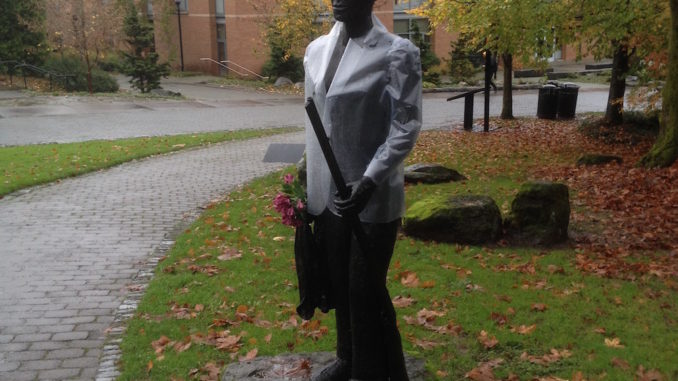
By Kendall Arlasky
If you’ve ever walked the crowded path that surrounds the Glade, you may have noticed a statue of a tall black man. This statue is of William Clark’s slave, York, who was a part of the Corp of Discovery’s expedition West. While most Lewis & Clark College students can tell you the name of the man that the statute memorializes, many students don’t know the formal name of the artwork itself.
The memorial is named “York: Terra Incognita.” This phrase means “unexplored territory” and helps us remember that there are many aspects of York’s life that remain unknown and unexplored even today.
The process of creating York was not an easy task. A former law student named Charles Neal ’07 decided that LC did not have enough representation of diversity and felt unwelcome as a result.
“Charles Neal was struck by the fact that LC has the name of the two explorers, the leaders of the Corp of Discovery, but no representation of York,” Linda Tesner, Director of the Hoffman Gallery, said.
Tesner is also the chair of the committee who brought this idea to life. The committee had a hard time deciding what the memorial would be.
“I wanted an image to show who York was,” Tesner said. “Other people on the committee felt very strongly that that was not what they wanted. So the very first thing we did was we got into a room and we all talked about our hopes and dreams for the York Memorial with the moderator. At the end of the day we came up with a very simple way of thinking about York. We wanted him to be portrayed as both a slave and a significant.”
Once it was decided that York would be commemorated with a sculpture, the committee sent out a call to artists for proposals. They were at a loss until Tesner stumbled across Alison Saar’s work and sought her out. Saar had seen the proposal and knew exactly what she wanted to do. Tesner described Saar’s vision as a York who looks abstracted enough so that you know it’s an African man but not someone you would recognize. She wanted him to be facing west and holding a rifle. Saar also wanted him to be shirtless so that from the behind you could see a map carved into his back. This map in Saar’s vision was going to represent the map that William Clark made in which he honored York by naming a dry river creek bed after him.
The committee loved the idea and commissioned Saar to complete the sculpture.
There are multiple components of the sculpture, many of which draw a response out of students.
“If you see York you can’t help but respond to him,” Tesner said. “I think that there’s something about that sculpture that makes you want to know more about the story.”
Students in particular seem to respond to York. Kaes Vanderspek ’21 noticed that there is a culture on campus that forces the students to recognize and acknowledge York.
“Everyone knows the story of (Meriwether) Lewis and (William) Clark, but I didn’t know the story of York before I came here,” Vanderspek said. “We need to honor those people who have been historically ignored. It reminds you on a daily basis that these things that we enjoy are built on atrocities and suffering. While it is uncomfortable, it is something that we need to be reminded of time and time again.”
Some of the students at LC have a tradition of leaving small gifts for York, such as food or flowers.
“Whenever I go by it and I see more flowers it just makes me smile,” Vanderspek said. “There was a single rose and one day I noticed it had fallen and so I put it back. The next day there was an entire bouquet. It’s a very cool and silent form of respect.”
Tesner said that Saar is thrilled by these small acts of kindness.
“She loves it,” Tesner said. “Especially last year when the raincoat was put on him by an art student. It seemed like the student cared about York and his comfort.”
Dahlia Ana Dant ’18 has been walking past York for years, and as a result has some thoughts about the statue’s role in campus culture.
“I appreciate that the statue honors a person of color, but it is wrong to have a depiction of (Meriwether) Lewis and (William) Clark’s slave while the school carries their names,” Dant said via email. “This reverses the apparent honor bestowed upon York and attempts to erase the violent colonization that (the explorers) carried out.”
Regarding the controversy surrounding York, Dant talked about the need for the school to “decolonize” by returning all the native artwork and educating every student about the marginalized groups of the corps of discovery. Then, as a final step, changing the school’s name.
York’s memorial is a reminder of his presence in history and can be viewed often not only be students but faculty as well because of it’s presence in one of the most travelled areas on campus. His memorial is meant to invite us to take a journey and explore some of our own terra incognitas.
Subscribe to the Mossy Log Newsletter
Stay up to date with the goings-on at Lewis & Clark! Get the top stories or your favorite section delivered to your inbox whenever we release a new issue.

Leave a Reply